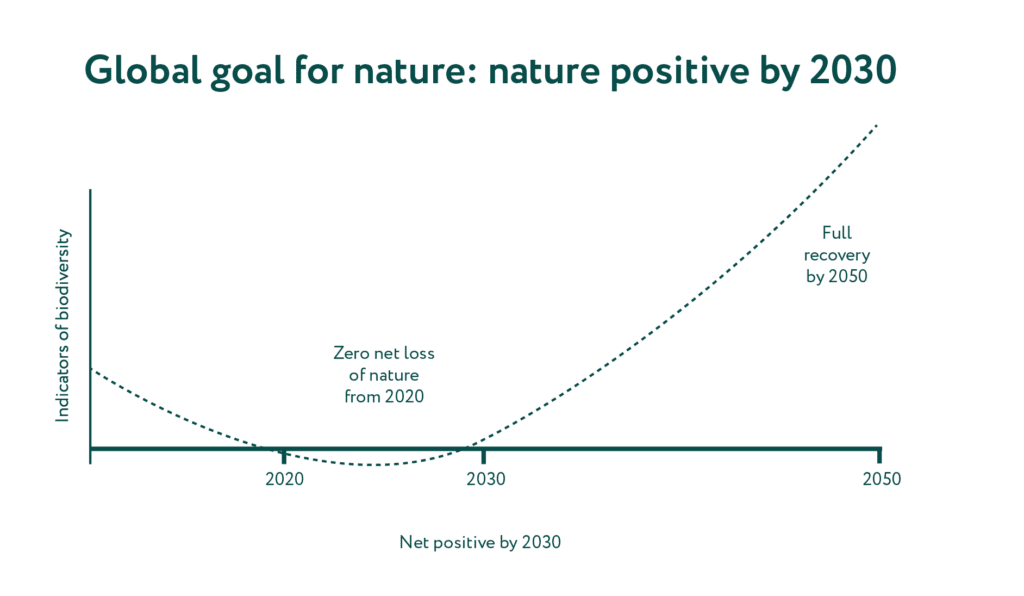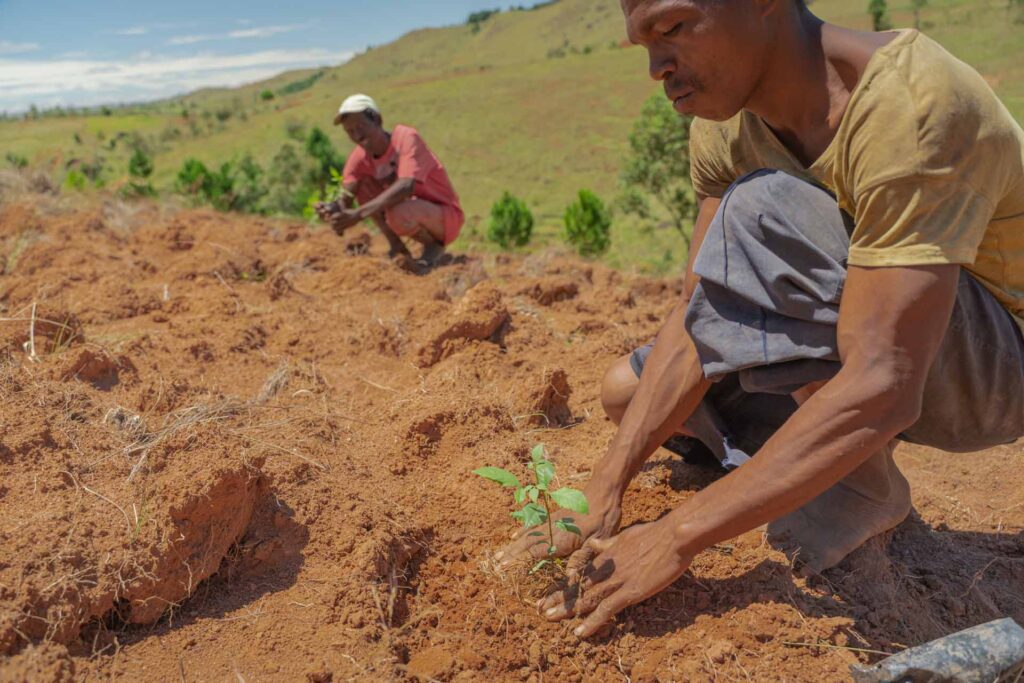For years, net zero has been the dominant framework for climate action. But as biodiversity loss accelerates and ecosystems collapse, it’s clear that carbon neutrality alone won’t secure a livable planet. A new paradigm is emerging. One that recognizes nature as the foundation of climate stability, human health and economic resilience. That paradigm is nature positive.
What does “nature positive” mean?
Nature positive is a global goal to halt and reverse nature loss by 2030, measured from a 2020 baseline, and to achieve full recovery by 2050. This framework was proposed by leading scientists and conservationists in A Nature-Positive World: The Global Goal for Nature and is in line with the mission of the Kunming-Montreal Global Biodiversity Framework (GBF).
Nature positive by 2030 serves as a strategic framework to drive initiatives that address climate change and restore biodiversity. This global goal reflects the urgency of restoring ecosystems and safeguarding the Earth’s life-support systems. It enables stronger integration between biodiversity initiatives and other environmental frameworks, including climate action, ocean conservation and land degradation prevention.

Why net zero isn’t enough
Net zero is a cornerstone of global climate strategy, essential for reducing greenhouse gas emissions and limiting global warming to 1.5°C, as agreed under the Paris Agreement. Yet increasingly, scientific consensus makes it clear: this goal cannot succeed in isolation. Without halting and reversing nature loss, the essence of a nature positive approach, we threaten the very systems that allow net zero to work.
Net zero targets focus primarily on reducing emissions from fossil fuels, industrial processes and energy systems. However, they often overlook the role of natural ecosystems in regulating the climate. Climate stability and ecological integrity are tightly bound. Forests, wetlands, oceans and soils absorb carbon, manage water cycles and buffer extreme weather events. When degraded, these ecosystems not only release stored carbon but also lose their capacity to support adaptation and resilience.
In other words, the degradation of nature endangers Earth system stability. Biodiversity loss, deforestation and ocean acidification are accelerating pressures that push planetary boundaries beyond safe limits. As the authors of The Nature-Positive Global Goal for Nature make clear, net zero without nature positive risks being an empty promise.
Put simply: climate change and biodiversity loss are two fronts of the same planetary emergency. Tackling one without the other means we will fail at both. Only through a nature positive lens, preserving and restoring ecosystems while decarbonizing, can net zero become a meaningful path forward.

The business case for nature positive
According to PwC’s analysis, over 55% of global GDP, equivalent to $58 trillion, is moderately or highly dependent on nature. From agriculture and pharmaceuticals to tourism and infrastructure, businesses rely on healthy ecosystems for raw materials, supply chain stability and risk mitigation.
Biodiversity loss and ecosystem degradation pose direct risks to business operations:
- Supply chain disruptions from deforestation, droughts or invasive species
- Reputational damage from unsustainable sourcing (e.g. palm oil, mining)
- Regulatory pressure from emerging frameworks
Companies that fail to account for nature-related risks may face credit downgrades, investor divestment and declining market share.
Conversely, nature positive strategies offer significant opportunities:
- Tech giants are embracing nature-based solutions to offset operational emissions. This not just as carbon accounting tools, but as a way to support community-led reforestation and conservation efforts. These initiatives strengthen ESG performance and deliver long-term social impact.
- Consumer goods brands are funding reforestation to secure future access to critical natural resources while building climate-resilient supply chains.
- Financial institutions are launching biodiversity-linked financial products that channel capital into regenerative agriculture, forest conservation and ecosystem restoration. These instruments offer returns while meeting new sustainability disclosure requirements and investor expectations.
Nature positive strategies are no longer abstract. Businesses have access to concrete tools to measure and manage their environmental impact:
- The LEAP framework of the Taskforce on Nature-related Financial Disclosures (TNFD) helps companies map where their activities intersect with nature, assess risks like deforestation or water stress and prepare disclosures aligned with ESG reporting.
- Science Based Targets Network (SBTN) enables businesses to set clear, science-driven goals for land use, freshwater and biodiversity across their operations and supply chains.
This makes nature positive measurable, credible and investor-ready.
Restoration: more than tree planting
True restoration rebuilds functional ecosystems. The Ten Golden Rules for Reforestation stress that efforts must be:
- Locally adapted and biodiverse: using native species that support ecosystem resilience
- Inclusive of local and indigenous communities: ensuring meaningful participation and stewardship
- Designed for long-term ecological monitoring: tracking progress over time to measure real impact
At Go Forest, we apply these principles daily. Our projects prioritize native tree species, collaborate with trusted local partners and include continuous monitoring to ensure long-lasting benefits for climate, biodiversity and community wellbeing.
Reference List
- Locke, H., Rockström, J., Bakker, P., Bapna, M., Gough, M., Hilty, J., Lambertini, M., Morris, J., Rodriguez, C. M., Samper, C., Sanjayan, M., Zabey, E., & Zurita, P. (2021). A nature-positive world: The global goal for nature. Nature Positive Initiative.
- Convention on Biological Diversity. (2022). Kunming-Montreal Global Biodiversity Framework. https://www.cbd.int/article/cop15-final-text-kunming-montreal-gbf-221222
- Nature Positive Initiative. (2024). Principles for nature positive measurability. https://www.naturepositive.org/app/uploads/2024/02/Principles-for-Nature-Positive-Measurability.pdf
- (2023). PwC boosts global nature and biodiversity capabilities with new Centre for Nature Positive Business. https://www.pwc.com/gx/en/news-room/press-releases/2023/pwcboosts-global-nature-and-biodiversity-capabilities.html
- Science Based Targets Network. (2023). Science-based targets for nature: Initial guidance for business. https://sciencebasedtargetsnetwork.org/how-it-works/the-first-science-based-targets-for-nature/
- Taskforce on Nature-related Financial Disclosures. (2023). Recommendations of the Taskforce on Nature-related Financial Disclosures. https://tnfd.global/wp-content/uploads/2023/08/Recommendations_of_the_Taskforce_on_Nature-related_Financial_Disclosures_September_2023.pdf
- World Economic Forum. (2020). Nature risk rising: Why the crisis engulfing nature matters for business and the economy. https://www.weforum.org/reports/nature-risk-rising-why-the-crisis-engulfing-nature-matters-for-business-and-the-economy
- World Economic Forum. (2020). The future of nature and business. https://www3.weforum.org/docs/WEF_The_Future_Of_Nature_And_Business_2020.pdf
- Di Sacco, A., Hardwick, K. A., Blakesley, D., Elliott, S., Ruyonga, G., & Sasaki, N. (2021). Ten golden rules for reforestation to optimize carbon sequestration, biodiversity recovery and livelihood benefits. Global Change Biology, 27(6), 1328–1348. https://doi.org/10.1111/gcb.15498


